
Exploring China
Beijing, Xi'an, Chengdu, Songpan, Yangshuo
 |
Exploring China |
Beijing - Xi'an - Chengdu - Songpan - Yangshuo - Back in Beijing

Organized by TrekTrek, Slovenia
Duration: 19 days
Group size: 8
Tour guide: Roman Križanič
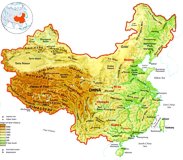 Map of China |
 Photographs presented were taken with Canon PowerShot S2 IS digital camera, originally taken in
2592 x 1944 (5 MPixel) resolution and downsampled for the web site to 1280 x 960. Original photos
are also available on a DVD version. Most images were digitally adjusted for optimal color and
contrast to compensate for exposure errors. There are a total of 848 photos in this gallery,
additional 126 were not included.
Photographs presented were taken with Canon PowerShot S2 IS digital camera, originally taken in
2592 x 1944 (5 MPixel) resolution and downsampled for the web site to 1280 x 960. Original photos
are also available on a DVD version. Most images were digitally adjusted for optimal color and
contrast to compensate for exposure errors. There are a total of 848 photos in this gallery,
additional 126 were not included.
It goes without saying - click on any thumbnail for a larger picture.
Beijing
To begin our jurney, we gathered in the late morning in Ljubljana, and drove by van to Muenchen, Germany to catch a night Air China flight to Beijing.
 |
 |
 |
 |
 |
| Munich International Airport |
Our Air China B-767 | Flying over Mongolia and northern China... | ||
 |
 |
 |
 |
| ...before landing in Beijing the next morning local time. | |||
 |
 |
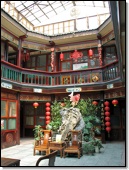 |
 |
 |
| Initial impressions of Beijing while driving from the airport |
The first home away from home, an ex-brothel, Leo Hostel | |||
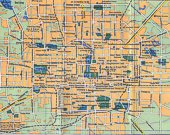 |
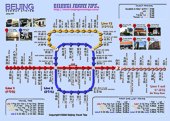 |
| Map of Beijing City Center | Beijing Subway Map |
Having settled down after a long flight, in the afternoon we took a walk and visited the nearby Tian'anmen Square.
 |
 |
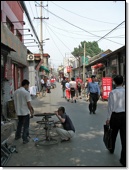 |
 |
 |
|
Leo Hostel has a near-perfect location, within walking distance of Tian'anmen Square and the Forbidden City, and in the one of the few remaining old parts of the city, with busy market streets. |
||||
 |
 |
 |
 |
 |
| Locals gather for board games, and street vendors offer a quick snack | The Qianmen Gate (Front Gate) and Arrow Tower, south of the Tian'anmen Square and the Forbidden City |
|||
 |
 |
 |
 |
 |
| The Tian'anmen Square, the largest public square in the world |
Kite flyers | Tian'anmen Gate, entrance to the Forbidden City |
Monument to the People's Heroes, with Chinese History Museum |
|
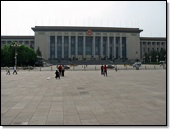 |
 |
 |
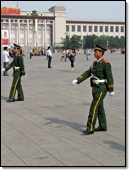 |
 |
| Great Hall of the People | Mao Zedong Mausoleum | Guards at the Tian'anmen Square | ||
The following day was reserved for paying a visit to the most famous of Chinese landmarks, The Great Wall.
We have opted to go to the Simatai section of the wall - a bit remote, less crowded than some more visited
locations, highly authentic, and earning the reputation of being the most beautiful section of the Great Wall.
Simatai is some 130 kilometers to the north-east of Beijing, about three hours of driving.
 |
 |
 |
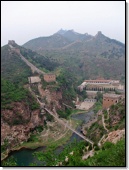 |
 |
| Making our way to the wall |
There are two sections of the wall in Simatai, eastern and western, divided by a river valley |
The first two towers on the steep eastern side |
||
 |
 |
 |
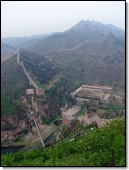 |
 |
| All the way up we were accompanied by a group of friendly local women, selling souvenirs |
A view to the west... |
...and further up the never-ending stone stairs |
||
 |
 |
 |
 |
 |
| Inside one of the towers | Relentlessly attacking the stairs and quickly gaining height |
|||
 |
 |
 |
 |
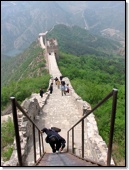 |
| Half way up, the final few towers ahead |
Simatai entry with path to The Wall |
In some parts, The Wall is narrow... |
...while other sections are a challenge on their own |
|
 |
 |
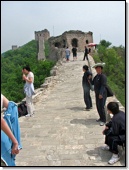 |
 |
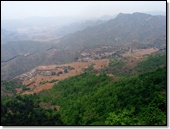 |
| Massive guard towers | A quick photo session before the next group of stairs |
Some of the bricks carry old inscriptions |
View to the north, that's Mongolia over there |
|
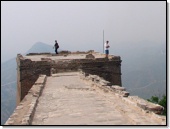 |
 |
 |
 |
| The top of one of the guard towers |
The Wall goes on, 6.700 km in total |
Ever-present souvenir vendors high up on the wall |
Almost at the top, it's not that steep anymore |
 |
 |
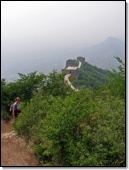 |
 |
| Reaching the last accessible tower on the east side, the rest is closed to the public |
Starting our way back down the stairs, the souvenirs ladies went into action |
||
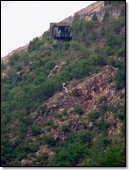 |
 |
 |
 |
 |
| Instead of walking for 30 min, you can take the flying fox and slide down over the lake in half a minute |
A short boat ride takes you back to the entry |
Driving back to Beijing through local villages |
||
Before moving out of the Beijing and proceeding to central China, we had one more great landmark left to visit, The Forbidden City (or The Palace Museum, as Chinese would like to have it called now days). On our way there, we stopped at The Great Hall of the People, the Chinese parliament, for a quick tour.
 |
 |
 |
 |
 |
| Walking by the Tian'anmen Square, there are lots of Chinese own tourist groups |
First, we pay a visit to the parliament |
The vast main lobby | ||
 |
 |
 |
 |
 |
| Hunan Hall | Those are expensive looking... |
There is a lot of art in all halls | ||
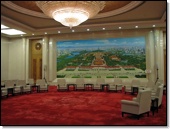 |
 |
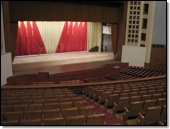 |
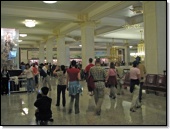 |
 |
| Beijing Hall | The main auditorium | The main lobby from upstairs | ||
 |
 |
 |
 |
 |
| The Ballroom | Shanghai Hall | Several other halls for meetings | Chinese parliament drive park |
|
 |
 |
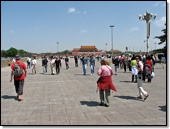 |
 |
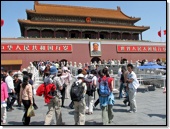 |
| The Great Hall of the People from the outside, with a neat small park in the front of it |
Back on the Tian'anmen Square, Forbidden City entry ahead |
Tian'anmen Gate and seven arched bridges in the front |
||
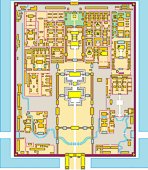 Forbidden City Map |
 |
 |
 |
 |
 |
| Entering the Forbidden City area |
It's hot, it's Sunday, and it's crowded | The Meridian Gate | ||
 |
 |
 |
 |
 |
| The inner courtyard with five bridges over the Golden River |
Bridges over the Golden River |
The Gate of Supreme Harmony |
Details of the gate's roof |
|
 |
 |
 |
 |
 |
| Golden roofs of the gates |
The Hall of Preserving Harmony. The number of animals on roof's corners mark the importance of the building |
The throne inside | The square north of The Hall of Preserving Harmony |
|
 |
 |
 |
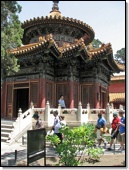 |
 |
| Details of the Imperial Garden, the northmost part of the Forbidden City | ||||
 |
 |
 |
 |
| A wide water trench surrounds the Forbidden City |
Behind the North Gate is a Jingshan Park with the prospect hill, and The Pavilion of Everlasting Spring on top, offering great views of Beijing. |
||
 |
 |
 |
 |
 |
 |
 |
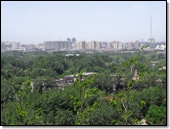 |
 |
 |
| Panoramic views of Beijing from the top of the hill | ||||
To sum up the day, we took the subway to the nearby Silk Street (Xiushui Market), famous shopping center notorious for counterfeit designer brands and heavy bargaining. What used to be an outdoor market is now a five storey shopping mall. We will be returning here on our last day in China for some serious shopping.
 |
 |
 |
 |
| Beijing subway | Most of Beijing is under construction |
Silk Market, packed with counterfeited goods |
Chinese have a sense of humor |
Xi'an
In the evening that day, we left Beijing on a sleeper train and moved overnight to Xi'an. Xian is the capital of Shaanxi province with a population of over 3 million, and one of the most important cities in Chinese history. Today, Xi'an has become an important cultural, industrial and educational center of the central-northwest region. Many of us liked Xi'an the most of all cities visited.
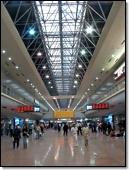 |
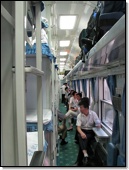 |
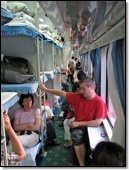 |
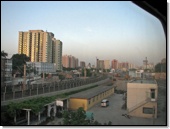 |
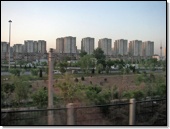 |
| Beijing train station | On the train | Scenery while leaving Beijing | ||
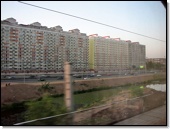 |
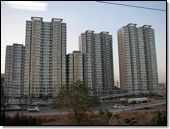 |
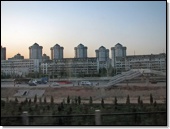 |
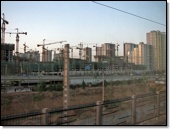 |
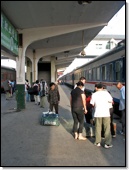 |
| Many vast sleeping neighborhoods by the railroad, and building even more... | Reaching Xi'an early in the morning |
|||
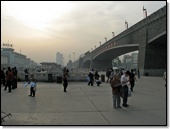 |
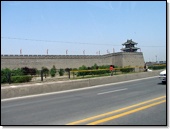 |
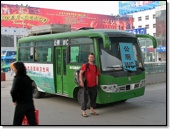 |
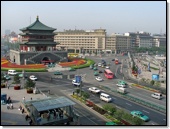 |
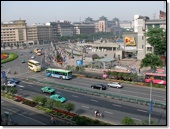 |
| The city is surrounded by a well-preserved wide city wall, dating to the Ming Dynasty (1374), 12 meters high, and spanning 13.7 kilometers. |
A toilet on the move | Xi'an city center, the Bell Tower | ||
After settling in the Bell Tower Youth Hostel, right in the city center, we took off some 40 km east of Xi'an
to see one of the main attractions in the area, the Terra Cotta Warriors.
Terra Cotta Warriors, the Mausoleum of Emperor Qin Shi Huang, is the burial place of the first unifier of China,
surrounded by an army of nearly 8.000 life-size clay figures, horses and chariots, buried there for over 2.000 years.
Not two figures are the same. The Terracotta Army was discovered in 1974 by local farmers drilling a water well, and
is considered the most significant archeological excavation of the 20th century.
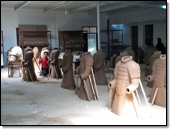 |
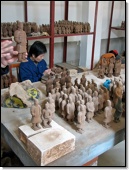 |
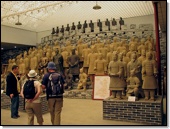 |
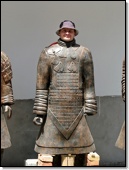 |
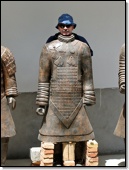 |
| On the way, we have stopped in one of the local shops, where they make and sell replicas of Terra Cotta warriors |
Be a Terra Cotta warrior | |||
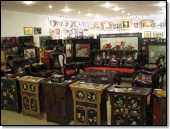 |
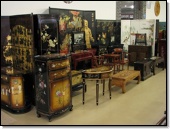 |
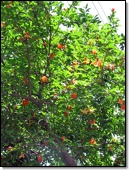 |
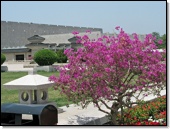 |
| They also make beautiful Chinese style furniture and carpets |
Arriving to the Terra Cotta museum site | ||
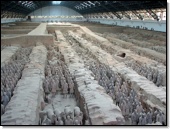 |
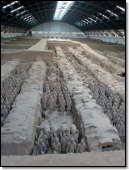 |
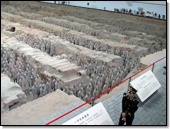 |
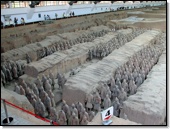 |
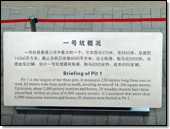 |
| An amazing view on the Pit 1, with more than 2.000 clay solders, horses, and chariots dug up so far, estimated a total of 6.000 of them standing there in a battle formation |
||||
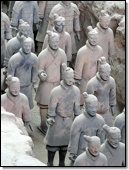 |
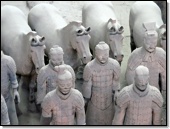 |
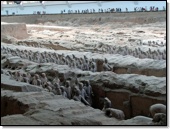 |
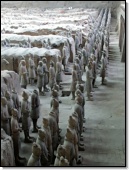 |
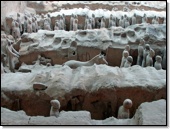 |
| A few close-ups. Each figure is different. | A view on the army from the side | |||
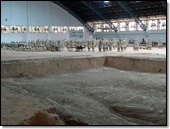 |
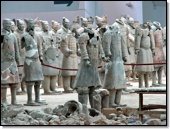 |
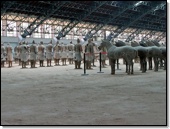 |
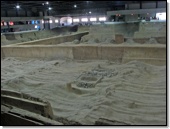 |
| Many figures have been destroyed or damaged, and are being reconstructed | Pit 2 contains four mobile combat units; some 1.000 warriors and 500 horses |
||
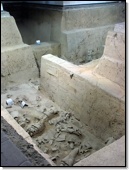 |
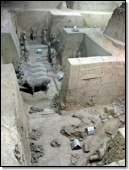 |
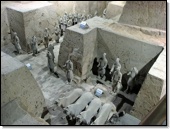 |
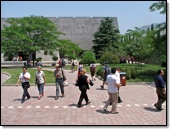 |
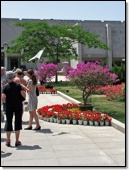 |
| Pit 3 is much smaller, and represents the command center or headquarters |
The whole museum complex is newly built around the location... |
|||
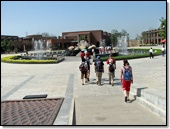 |
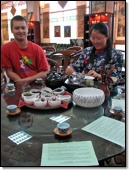 |
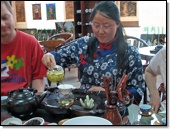 |
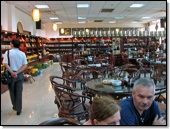 |
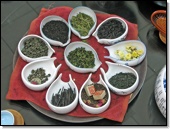 |
| ... with many accompanying activities |
One of them is a tea house, a welcome refuge from the heat to sample many kinds of Chinese tea |
All major kinds of tea | ||
Returning from Terra Cotta Warriors in late afternoon, we went cycling on the Xi'an city wall (Chengqiang). You can rent a bicycle right there on the top of the wall, and drive all the way around for the whole 14 kilometers.
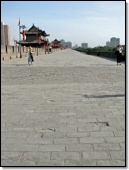 |
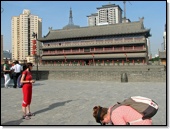 |
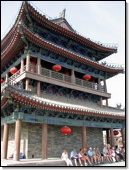 |
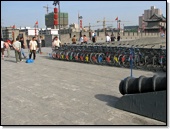 |
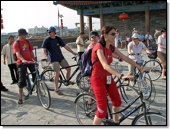 |
| On the top of the city wall | We picked up our bikes | |||
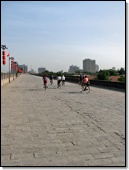 |
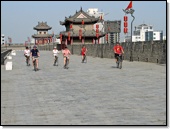 |
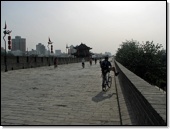 |
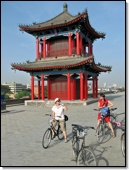 |
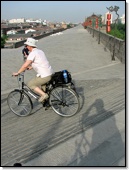 |
| It's a clear, sunny day, the heat has let off in the afternoon, and we are really enjoying it. | ||||
 |
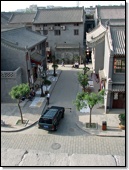 |
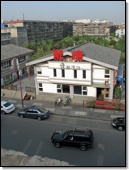 |
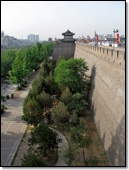 |
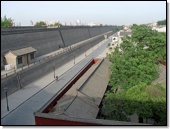 |
| Peeking over the wall on the streets below | The massive wall | |||
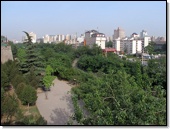 |
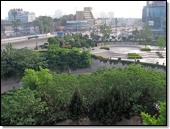 |
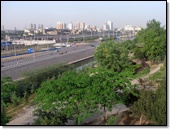 |
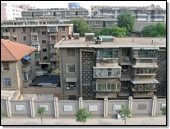 |
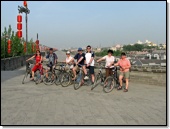 |
| A few impressions of the city from the top of the wall | A typical neighborhood |
Group photo at one of the corners |
||
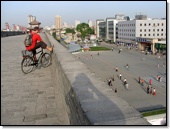 |
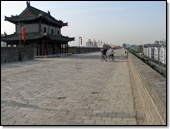 |
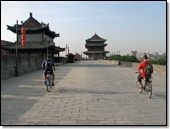 |
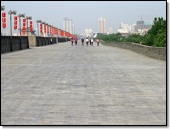 |
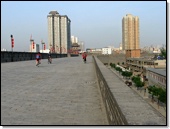 |
| Looking down on the crowd below |
It's an opportunity to get away from the crowds, the noise, and the traffic congestion. | |||
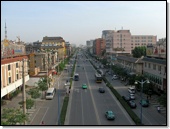 |
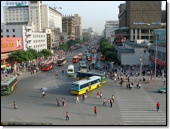 |
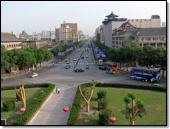 |
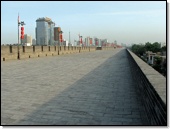 |
 |
| Main city avenues, the latter one going straight to the Bell Tower and our hostel |
Mixing old and new, these buildings are over 600 years apart |
|||
The day ended up with a tasty dinner in the Muslim Quarter, and later on with large quantities of action-priced beer at a local night club. The next day was free to go around the town on our own, until the afternoon, when we were catching another overnight sleeper train to the next destination, Chengdu.
Chengdu
Chengdu is the capital of the Sichuan province and the 5th most populous city in China, with estimated 11 million residents in the city area. As we quickly came to realize, due to its location Chengdu has one of the lowest sunshine rates in China, most of the days are foggy and cloudy. |
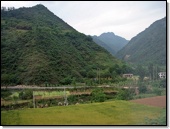 |
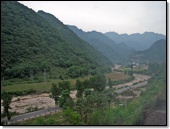 |
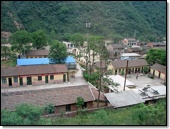 |
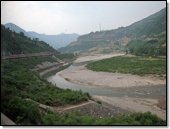 |
| Once again on the train. Countryside is getting more diverse, and train is driving slower than to Xi'an | ||||
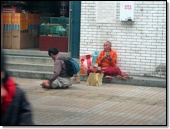 |
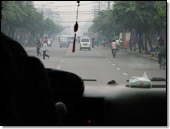 |
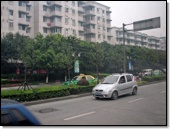 |
| City streets while driving to the hostel | ||
In Chengdu, we stayed at the Holly's Hostel. The plan for the day after putting down our luggage was to go to Leshan, 180 km south of Chengdu, and see the Giant Buddha, the tallest stone Buddha statue in the world, carved out of a cliff face on the Emei mountain. This was the first day we were let down by the weather, it's lightly drizzling most of the day.
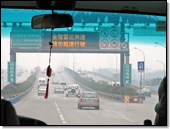 |
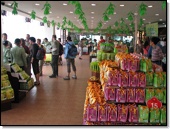 |
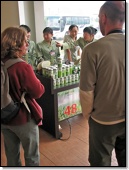 |
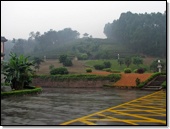 |
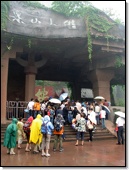 |
| Driving to Leshan, a thick fog all around |
Sichuan is one of the main green tea provinces, and Chengdu is well known for their teahouses. We stopped in one on the way. |
Entrance to the Giant Buddha site |
||
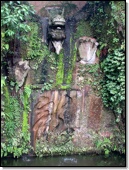 |
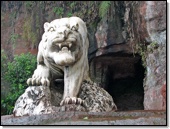 |
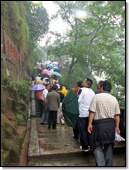 |
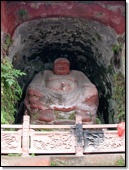 |
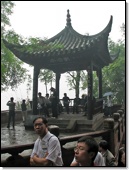 |
| There are many Buddha and other smaller statues along the path leading to the top of the Giant Buddha |
One of the pavilions where visitors can rest |
|||
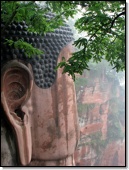 |
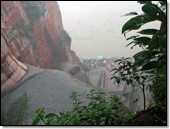 |
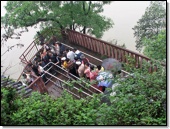 |
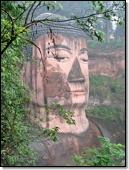 |
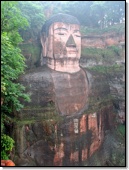 |
| Buddha's head and a view down to its feet by the river before starting to descend |
Even if raining, there is a long slow-moving line |
Slowly descending on Buddha's right side.. | ||
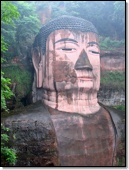 |
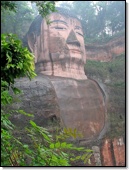 |
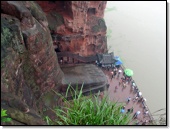 |
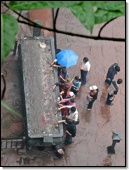 |
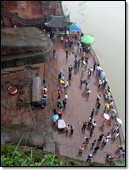 |
| ...on wet slippery stairs | A view to the bottom platform, worshippers lighting joss sticks | |||
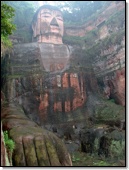 |
 |
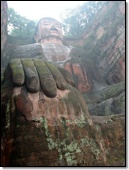 |
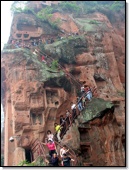 |
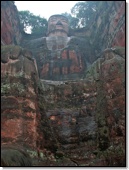 |
| Going further down with the crowd | Final descend to the bottom |
Giant Buddha as viewed from the feet up |
||
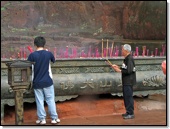 |
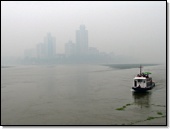 |
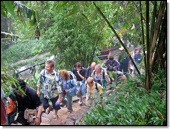 |
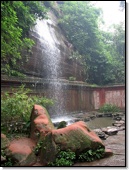 |
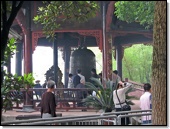 |
| Incense is burnt in a big pot at Buddha's feet |
Leshan city in a thick fog |
Taking the stairs on the other side back to the top, by a small waterfall |
A pavilion with a huge bell |
|
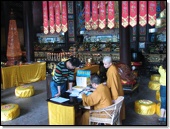 |
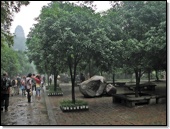 |
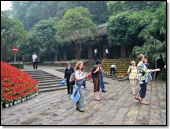 |
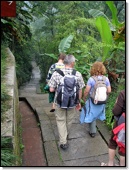 |
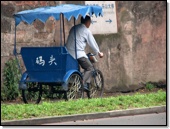 |
| Young monks presenting their work |
There is a beautiful and peaceful garden with thick vegetation behind the temple on the way down |
Everywhere to be seen, rickshaws |
||
The next day we have visited one of the Chinas greatest national treasures, pandas. Pandas are found in wild only in Sichuan, Shaanxi and Gansu provinces, and there are fewer than 1000 of them left, a majority of them in the Sichuan province. Just outside Chengdu is the Giant Panda Breeding and Research Center has been created and imitates the pandas' natural habitat in order that they might have a the best possible environment for rearing and breeding. The center is open to visitors for further scientific education and to improve public awareness of the protection of both wild creatures and their environment.
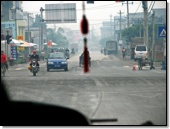 |
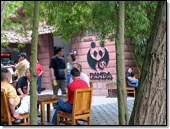 |
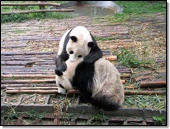 |
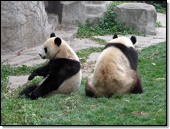 |
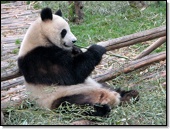 |
| Driving 10 km outside Chendu... |
... to the Giant Panda Breeding Research Center |
We are lucky, pandas are very active and playful this morning | ||
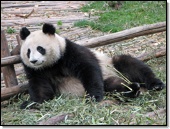 |
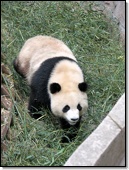 |
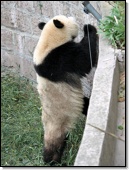 |
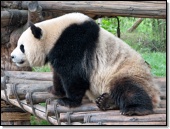 |
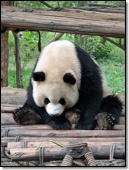 |
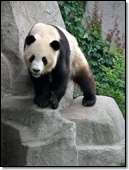 |
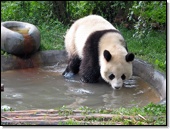 |
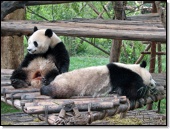 |
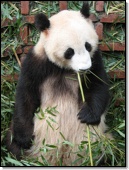 |
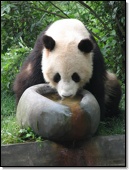 |
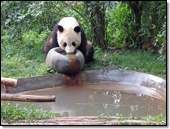 |
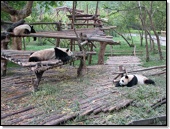 |
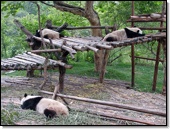 |
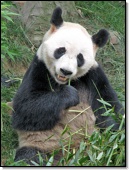 |
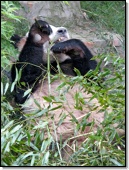 |
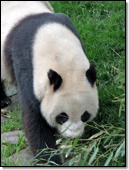 |
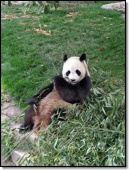 |
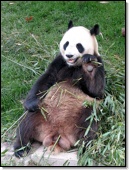 |
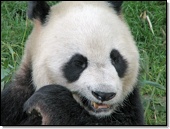 |
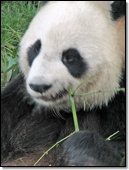 |
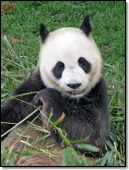 |
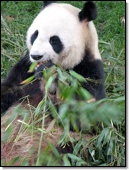 |
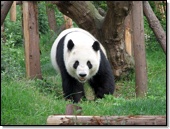 |
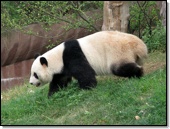 |
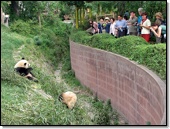 |
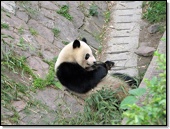 |
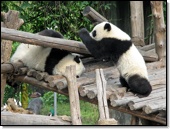 |
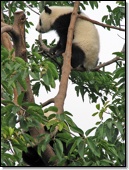 |
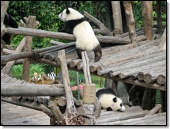 |
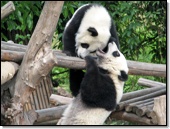 |
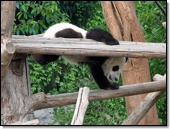 |
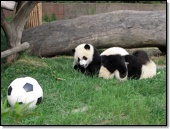 |
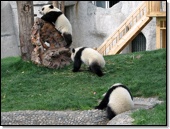 |
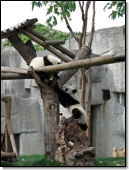 |
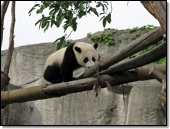 |
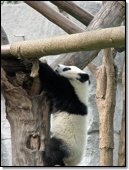 |
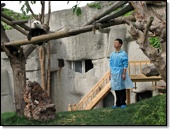 |
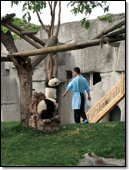 |
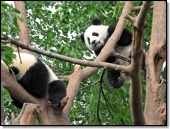 |
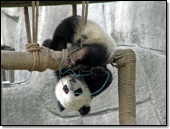 |
| Way too many photos of pandas. They have about 50 pandas in the center, of varying ages. | ||||
 |
| AVI Video clip 480x640, 30fps, XVID, MP3 stereo (17 seconds, 5.97 MB) |
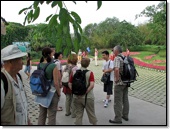 |
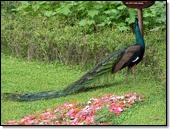 |
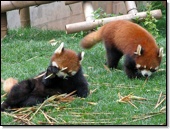 |
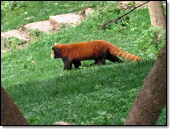 |
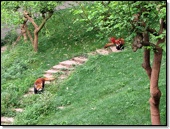 |
| The center is arranged as a very nice park |
There was a peacock walking around |
The center also has a few lesser pandas, also known as red pandas, or small pandas |
||
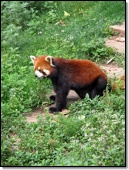 |
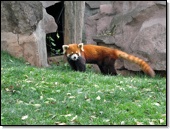 |
 |
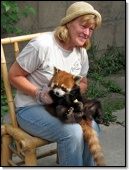 |
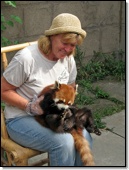 |
| They are much smaller than giant pandas, quite cute, and resemble a mixture between a fox and a raccoon |
For a fee, you take a picture with one | |||
Returning from the panda center, we visited the Wenshu Monastery, Chengdu's oldest, largest, and best-preserved Buddhist temple in the Chengdu city. We treated ourselves with a vegetarian lunch prepared by monks in the monastery's restaurant, and relaxed in the adjoining teahouse. The afternoon was free to explore the city on our own, and in the evening we are going to see a Chinese opera performance in the local theater.
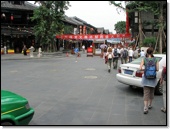 |
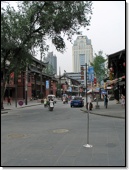 |
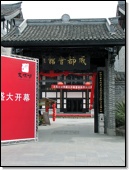 |
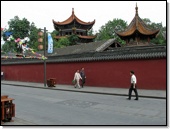 |
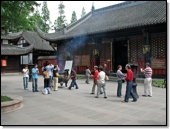 |
| Local streets with many small shops near the Wenshu monastery |
Wenshu monastery dates in the 6th century, it has almost 200 buildings, and comes with a distinct red wall |
|||
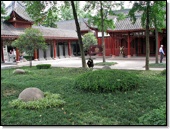 |
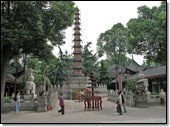 |
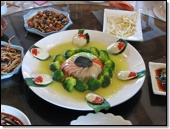 |
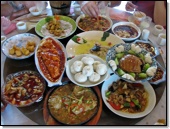 |
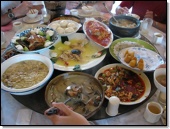 |
| Delicate gardens and statues inside the monastery | A nice meal in the monastery's restaurant, everything is vegetarian | |||
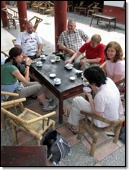 |
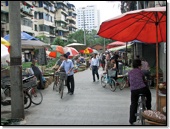 |
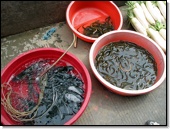 |
| Relaxing by a cup of green tea |
Walking around Chengdu and stumbling on a marketstreet |
Live fish and eel are common to find on markets |
In the evening, we visited the Sichuan Opera in the Shufengyayun Operatic Circle in the Chengdu Culture Park. With a cup of ever-present green tea you can enjoy performances like the famous magical Changing faces, where actors are capable of changing as many as 10 masks/makeups in less that 20 seconds, each with an instant split-moment gesture! Other performances also include musical solos, acrobatics, hand shadow show, Rolling Light (clown play while balancing a flaming bowl on one's head), and Spitting Fire.
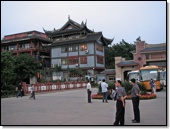 |
 |
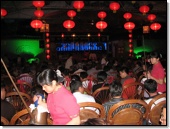 |
| Shufengyayun Opera in Chengdu |
Inside the theater | Attendants with special tea pots for refilling |
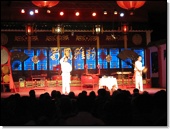 |
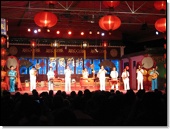 |
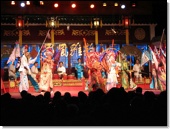 |
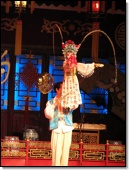 |
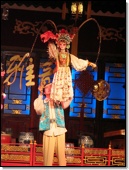 |
| Opening performance, traditional music, and a dancing act | Sichuan Opera puppets on sticks, amazing skills, puppet comes to life |
|||
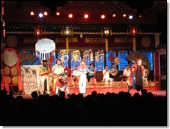 |
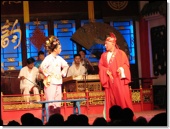 |
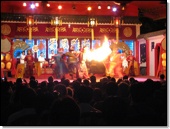 |
| One of the dancing routines |
A humorous play where wife punishes husband |
Changing Faces and Spitting Fire |
Songpan
Songpan is a charming small Tibetan countryside town in the northern reaches of Sichuan, lying at the foot of the Minshan Mountains, on altitude of about 2.900 meters. High altitude shows, especially for the first day, the simplest effort leaves you out of breath. The population, a mixed variety of ethnic groups, predominantly Qiang and Tibetans, live primarily on agriculture, raising livestock, and lately tourism. It is especially known for the horse trekking, which is what we were planning to do in the next three days. Songpan is about eight hours drive on the local bus line from Chengdu, travelling there pretty much takes the whole day. It's a quite an interesting ride though, and not one for the fainthearted - if you have seen Chinese drive, imagine them on a busy, narrow, curvy mountain road...
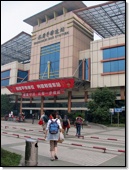 |
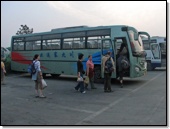 |
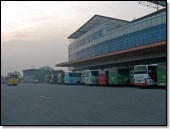 |
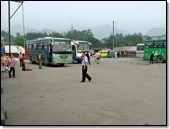 |
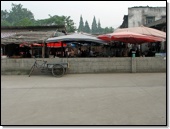 |
| Early in the morning on the Chengdu's bus station, leaving for Songpan | Making several quick stops on the nearby stations and markets, picking up people |
|||
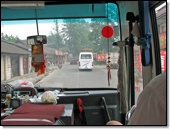 |
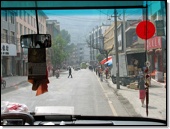 |
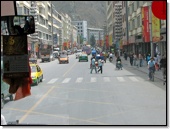 |
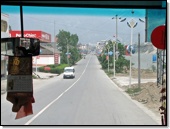 |
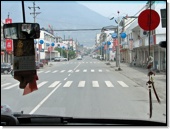 |
| We are passing through many small towns and villages on the way | ||||
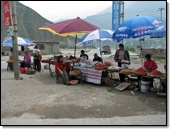 |
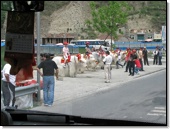 |
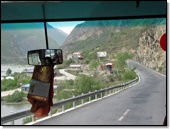 |
 |
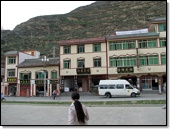 |
| A 10 minutes stop to stretch our legs |
Tourists posing on yaks |
The road gets more corners and turns uphill |
Obviously we are in the countryside now |
Arriving to the destination, Songpan |
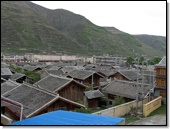 |
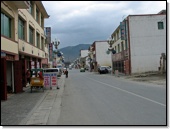 |
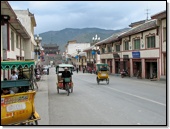 |
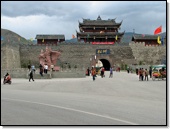 |
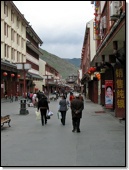 |
| A view on southern part of Songpan |
The main traffic road is routed around city walls |
The ancient gates to the city center... |
...leading to the main shopping street |
|
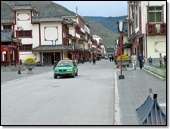 |
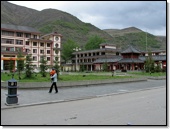 |
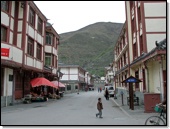 |
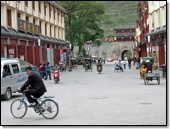 |
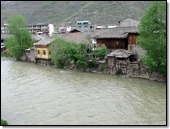 |
| There is very little motorized traffic within the city walls | The Mingjiang River is flowing through the city |
|||
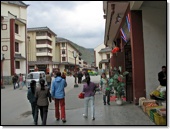 |
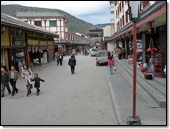 |
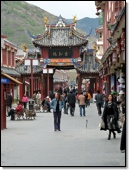 |
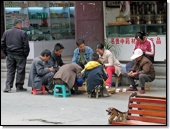 |
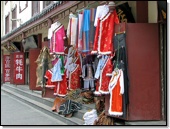 |
| The main city street is full of shops and small business, everybody is pitching in to help the business running |
If you are into ethnic clothes shopping, you will love it here |
|||
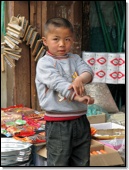 |
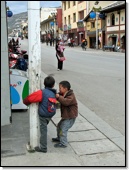 |
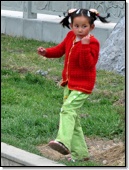 |
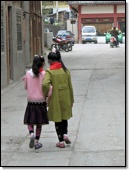 |
| Children in vivid colors are sparky, and just ask to be photographed | |||
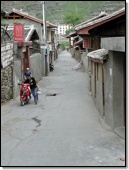 |
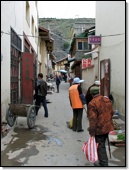 |
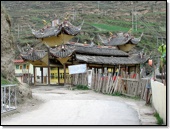 |
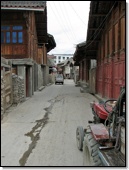 |
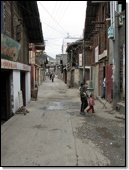 |
| If you step around the corner from the main road, local streets are immediately more like to what you would expect in a countryside |
||||
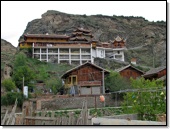 |
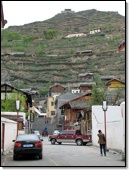 |
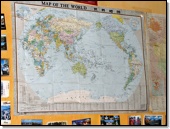 |
| Some houses stretch high up the hills, with a temple on the top |
A bit different map of the World |
|
Horse trekking is why most visitors come to Songpan. We have opted for a three-day trek, spending two nights
camping in tents, which is just about right not to get too demanding. We spent some three to four hours in the saddle
each day, with additional hour or two walking, the rest was devoted to camping, or taking on hiking trips on our own.
There is no need to be an experienced horse rider to enjoy this trip, horses know better what are they doing and where
are they going than we do.
Most horses do have an attitude problem. Not to us, but to other horses. They will furiously defend
their position in the line, biting around or springing in gallop on the steepest and narrowest slope to
cut the intruder off, should some other horse try to overtake. Apart from low branches, that's the most
likely reason to end up on the ground if you are not holding on tight.
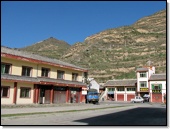 |
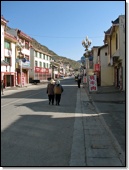 |
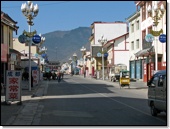 |
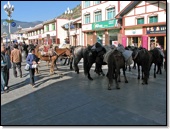 |
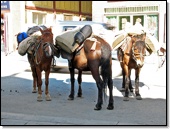 |
| The weather next morning is perfect, with clear blue skies, and our guides and horses are waiting | Our backpacks are tied to horses... |
|||
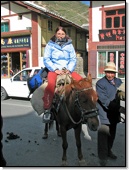 |
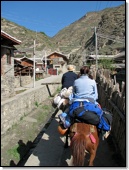 |
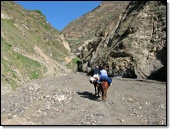 |
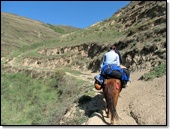 |
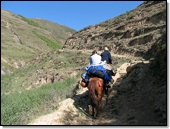 |
| ...then we are sat on... |
...and off we go | The trail leads us to a valley behind the town, and then uphill | ||
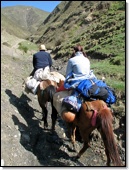 |
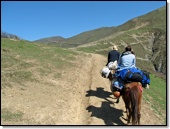 |
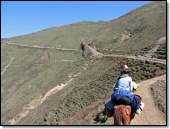 |
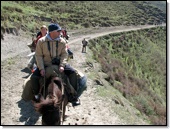 |
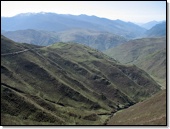 |
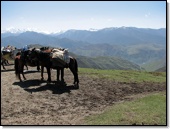 |
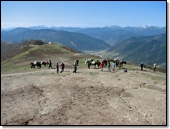 |
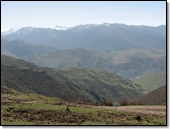 |
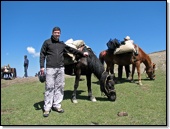 |
| Open scenery near Songpan, with snow peaked mountains in behind | Me and my horse | ||
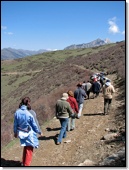 |
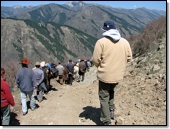 |
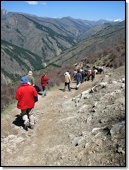 |
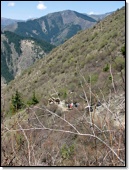 |
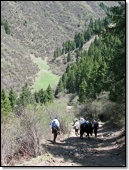 |
| Downhill we go on foot, as it's easier on fully loaded horses, and we need to stretch our legs anyway | ||||
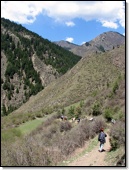 |
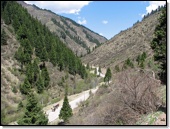 |
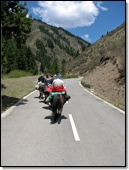 |
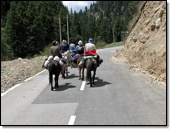 |
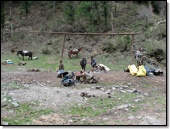 |
| There is a road going through the valley below... |
...and the last few kilometers we ride on the asphalt |
Around midday, we get to the first camp site |
||
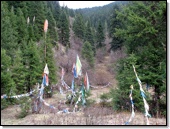 |
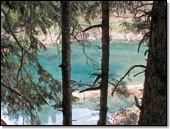 |
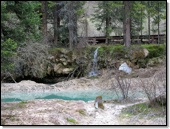 |
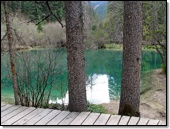 |
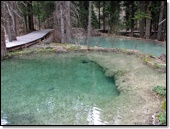 |
| Praying flags | Further uphill, the water situation improved considerably, and we enjoyed the walk | |||
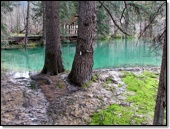 |
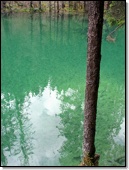 |
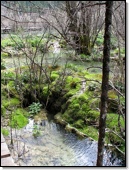 |
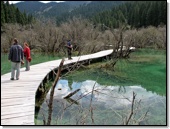 |
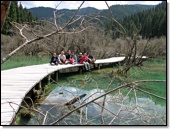 |
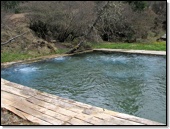 |
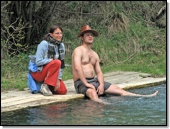 |
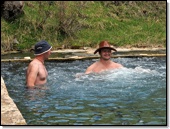 |
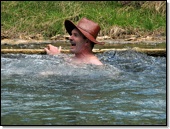 |
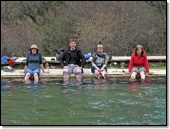 |
| Up on the top is a hot spring this park is known for, water is bubbling with slightly smelly gases |
Some were eager to jump in; others, not so much... | |||
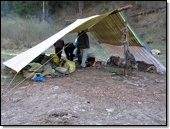 |
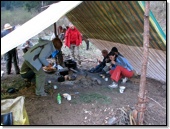 |
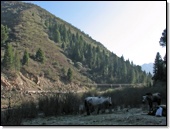 |
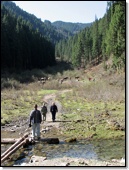 |
 |
| Having a dinner by the fire, before turning in for a very uncomfortable and cold night |
It is quite chilly in the morning, tents are still wet and frozen as the camp gets packed up |
We start up the valley |
||
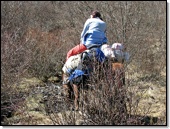 |
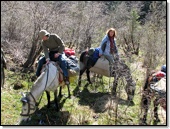 |
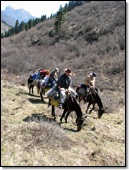 |
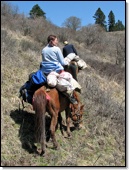 |
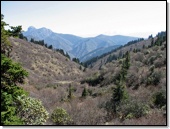 |
| The trail leads through bushes and a forest |
Terrain is steep and muddy, horses are stopping for a sip from the stream |
The view opens up as we near to the top of the hill |
||
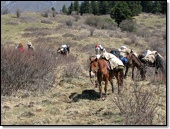 |
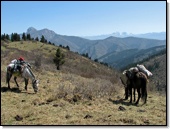 |
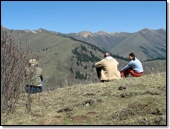 |
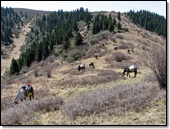 |
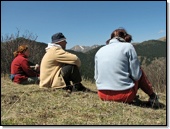 |
| Up on the summit, horses get a 20 minutes break before proceeding further, and we enjoy the scenery | ||||
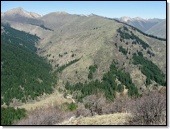 |
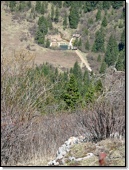 |
 |
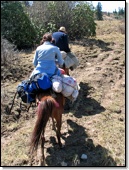 |
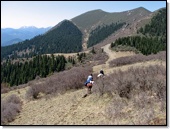 |
| The hot spring we visited yesterday is visible way down below |
On the move again, the trail is much easier, staying close to the top of hills |
|||
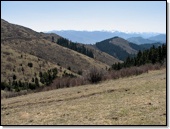 |
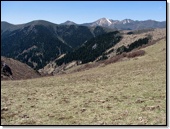 |
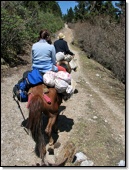 |
 |
 |
| We are quite high at this point, on altitude of about 3.700 meters |
Riding for one more hour, on a well maintained, easy going trail... |
...until we dismount for a walk down to the valley |
||
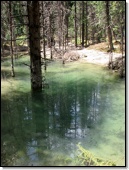 |
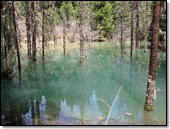 |
 |
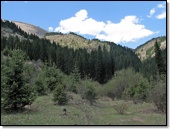 |
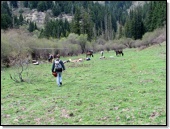 |
| On the way we stop at a forest lake... | ...and walk the rest of the way down the valley | Coming to the second camp site |
||
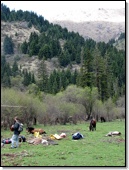 |
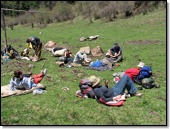 |
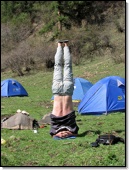 |
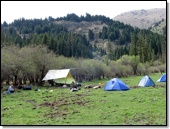 |
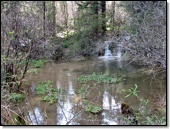 |
| Guides are preparing the camp... |
...and we do what we do best... |
...even some yoga | In the afternoon, our local friends gather the wood for the night, and we go sightseeing |
|
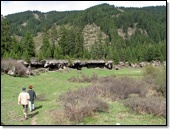 |
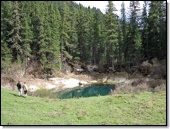 |
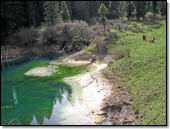 |
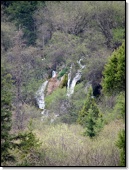 |
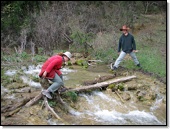 |
| We take a walk to a nearby lake, a beautiful one, although a bit empty at this time of a year |
Waterfalls a bit away upstream |
A tricky crossing | ||
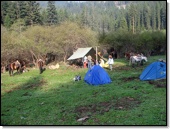 |
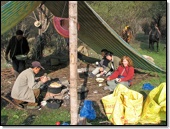 |
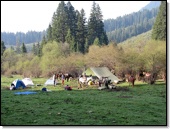 |
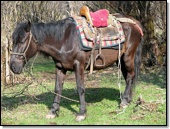 |
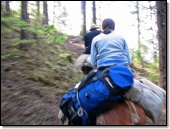 |
| In the morning, we have some breakfast... | ...while the guides pack up the camp |
My horse is waiting rather nervously |
Starting up through the woods |
|
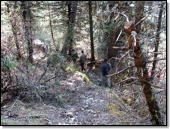 |
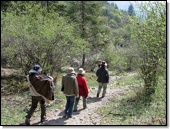 |
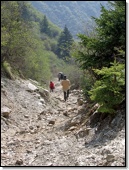 |
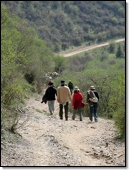 |
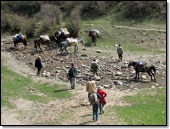 |
| As usual, we walk downhill behind the horses | ||||
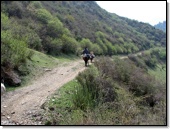 |
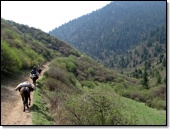 |
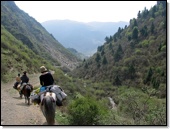 |
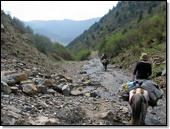 |
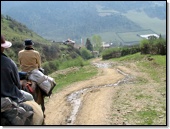 |
| Horses seem to be well motivated, they know they are going home today |
Around the corner, the first signs of civilization |
Just crossing this small scree... |
...and we enter a small village |
|
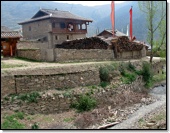 |
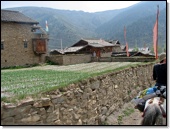 |
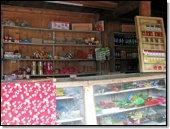 |
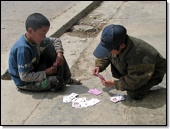 |
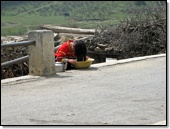 |
| Riding by stone-made houses | We stop for the first beer in several days |
Local boys are playing cards... |
...a small girl is washing her hair by the road... |
|
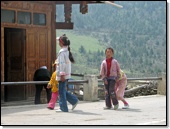 |
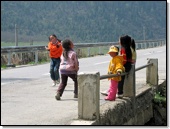 |
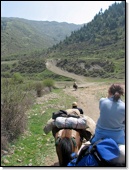 |
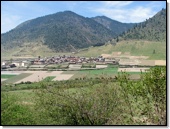 |
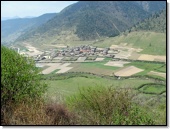 |
| ...and the rest of the kids just find us interesting and don't hesitate to show us their skills |
We need to press on. There is just one last hill to go over, and we are climbing again over the village |
|||
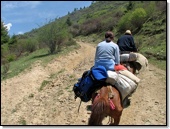 |
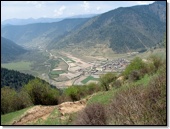 |
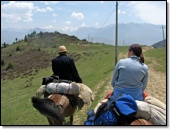 |
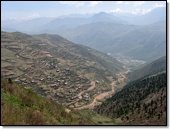 |
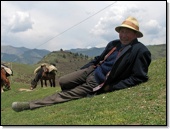 |
| The last climb of the trek |
We leave the village behind... |
...as we reach the top | Our goal is in sight, Songpan behind the hill |
The guide of our two horses is posing for us |
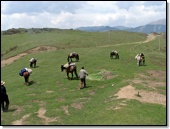 |
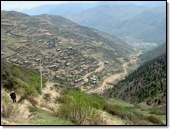 |
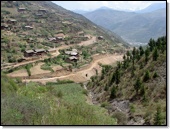 |
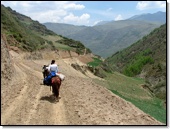 |
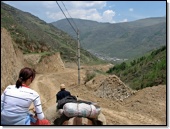 |
| Horses enjoy the green grass for a change |
We descend on foot down the last hill... | ...and then ride the final few miles to the town | ||
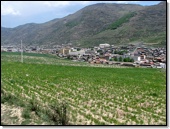 |
 |
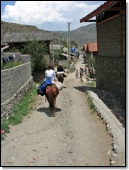 |
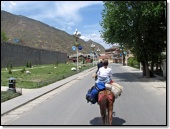 |
| After three days, the town of Songpan welcomes us back, hot showers awaiting |
We enter the buildings via back streets... |
...and ride triumphally through Songpan in the middle of the main road |
|
Showers were in high demand that afternoon, before we ventured out on individual shopping trips in the town.
Some of us have treated ourselves with Tibetan massage and foot massage before meeting for dinner in the most
popular hangout for foreigners in Songpan, Emma's Kitchen. Emma speaks excellent English, offers as western
food as you can find in China, and can help with everything you could possibly need.
The next morning, we have embarked on the same local bus line back to Chengdu, for another exhausting whole
day of driving.
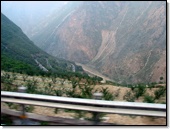 |
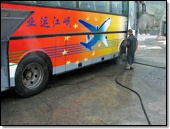 |
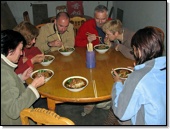 |
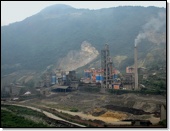 |
| Mountain road drops with sharp turns |
Cooling bus brakes after a long descend |
Delicious beef noodles in a small diner by the road |
China is destroying their environment |
Back in Chengdu
Some nine hours later, the bus finally stopped in Chengdu with our gratitude, and we have traded cold, clean,
high-altitude air for a multi-million city polluted and foggy one. We settled back at Holly's and retrieved the
excess luggage left there for safekeeping before going on horse trekking.
In the evening, we visited the Chengdu Bookworm. Partly because it is an unique blend of an English
language library, a bar, a Western restaurant, and a location of regular cultural events; and partly because
Velma, a fellow Slovenian now living in Chengdu, is a manager there, and we went to say "hi".
The next morning was free for last shopping in Chengdu, as early in the afternoon we are flying on to Guilin. Three of us have woken up earlier than necessary, in order to catch the morning activities in one of Chengdu's public parks.
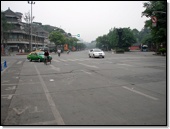 |
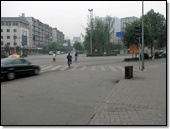 |
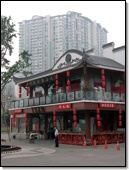 |
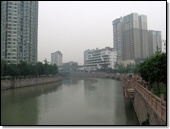 |
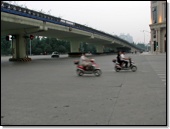 |
| It's too early for Chengdu people, streets are nearly deserted at 7 a.m. Two hours later, this will be crowded. | ||||
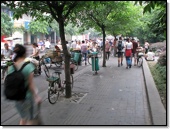 |
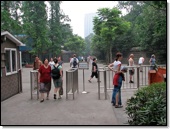 |
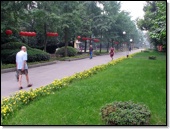 |
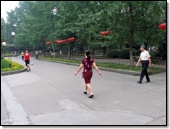 |
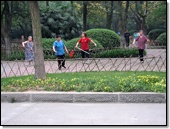 |
| A small market at park's gates is much more alive |
Park entry | An otherwise nicely maintained park is in the morning full of people of all ages... |
||
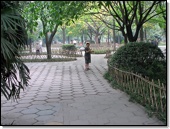 |
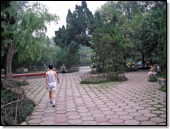 |
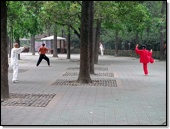 |
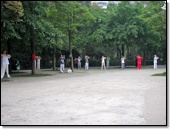 |
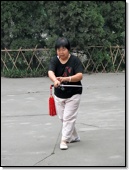 |
| ...running, exercising, ballroom dancing, practicing tai chi, or just relaxing in a teahouse by a morning cup of green tea | ||||
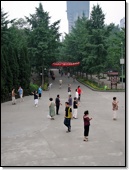 |
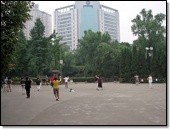 |
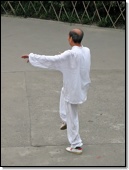 |
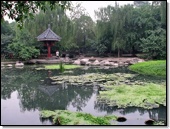 |
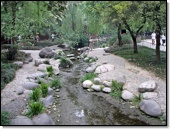 |
| Someone brings a tape player, and they dance in a group |
Some are true martial arts masters |
The park itself is relaxing and gives you energy for a new day |
||
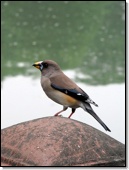 |
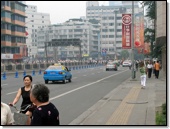 |
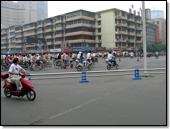 |
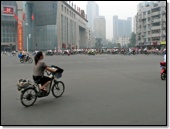 |
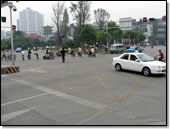 |
| A bird at the teahouse |
On the way back, city streets of Chengdu are packed already in a true Chinese fashion | |||
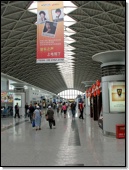 |
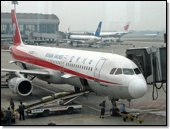 |
| At the Chengdu airport, waiting for a plane to Guilin |
|
Guilin, Yangshuo
The change of climate is obvious the second you step out in the open, it's hot and very humid. Guilin belongs to the subtropical region, but it's not the mild weather it is known for. Guilin is considered to be the pearl of China's tourist industry on account of the natural beauty of the karst landscape. The whole region stands on limestone, weathered and eroded by water, resulting in today's fantastic stone forests, peaks, underground streams and caves. The mountains in Guilin, rising abruptly from the ground, stand in various shapes, strangely-shaped peaks and in unique formation, characterize Guilin's scenery and have brought it world fame.
We have not stayed in the Guilin city itself, we drove 65 km to the south, to the smaller laid-back town of Yangshuo. Yangshuo by the Li river and surrounded by towering karst peaks has attracted a large number of international travelers.
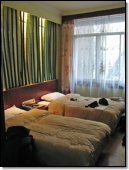 |
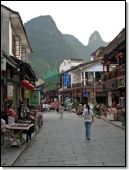 |
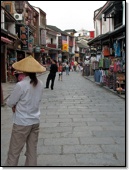 |
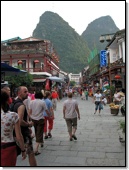 |
| A room at our hostel in Yangshuo |
The West Street in Yangshuo, flanked by small shops and vendor's stands selling all kinds of souvenirs and snacks. |
||
As it was almost an evening by the time we got settled in Yangshuo, it was a perfect time to visit one
of the local attractions, Cormoran fishing demonstration. While some fisherman still make a living
by using these birds, this is largely a tourist show now.
The basic principles are simple, you take a bunch of domesticated cormorans and tie a thin rope around
their necks. The rope is just tight enough to prevent them swallowing large enough fish. Birds are sent
fishing, with fisherman following in a boat closely behind. When a bird starts struggling with a fish
it can't swallow, it's pulled to the boat and fish is taken out.
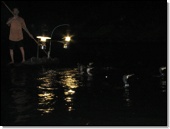 |
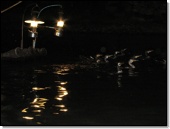 |
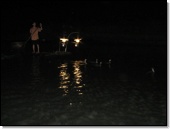 |
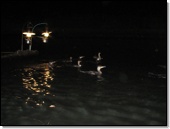 |
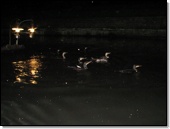 |
| Cormoran fishing is done by night, under a light that attracts fish. Cormorans dive for fish in front of the boat. | ||||
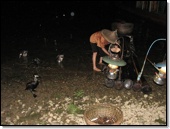 |
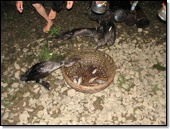 |
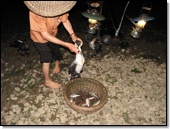 |
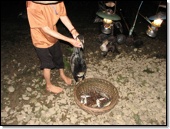 |
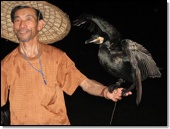 |
| We all stop on a shore |
For a demonstration how this works, birds are allowed to eat caught fish, which are then extracted back from their beaks |
Fisherman and his bird |
||
Bicycling is probably the best and most enjoyable way to experience the amazing limestone peaks that spread
for miles around, ride through rice paddy fields, and witness the real rural China by the river. Countless
roads and dirt tracks in the Yangshuo area are quiet, making them ideal for cycling and sightseeing.
We had a friendly local guide with us, and first we cycled to her home, very close to the famous Moon Hill,
for a home-cooked lunch.
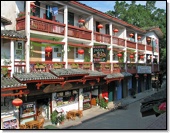 |
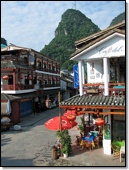 |
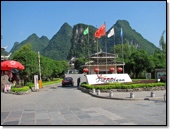 |
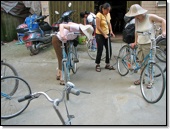 |
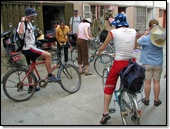 |
| We get some breakfast in the morning on our home street... | ...then we pick up our bikes for a day at the nearby bike rental shop |
|||
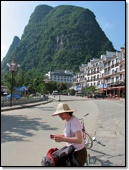 |
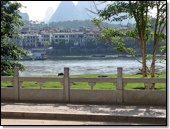 |
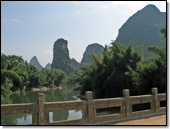 |
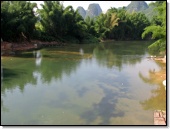 |
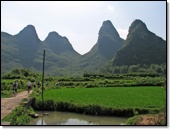 |
| Shortly after leaving Yangshuo and crossing the Li river we are in the countryside | Rice fields and mountains |
|||
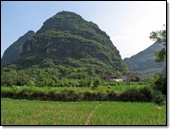 |
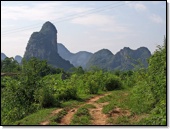 |
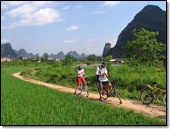 |
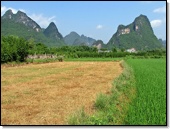 |
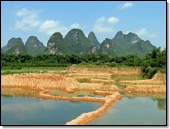 |
| The scenery around us is astonishing, we are stopping for photos all the time | ||||
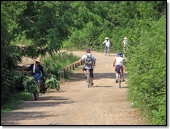 |
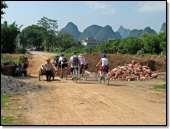 |
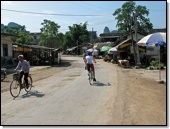 |
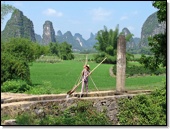 |
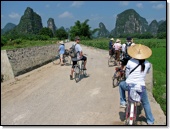 |
| Passing several small villages and locals going about their business | Chinese irrigation solution |
One more stop for sightseeing |
||
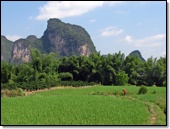 |
 |
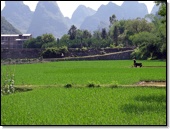 |
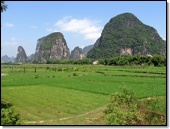 |
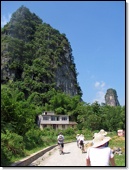 |
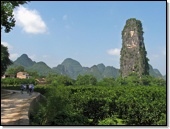 |
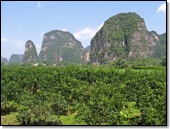 |
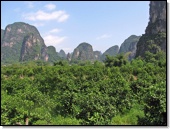 |
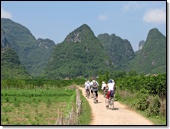 |
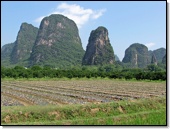 |
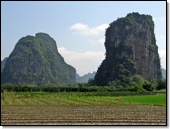 |
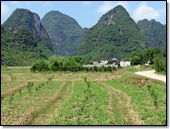 |
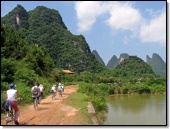 |
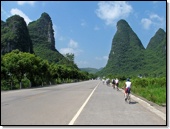 |
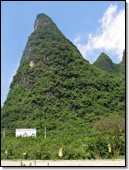 |
| More of the scenery as we are cycling some 8 km south of Yangshuo | The last stretch to the destination goes on a road | |||
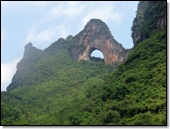 |
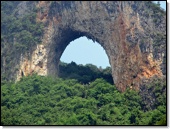 |
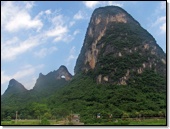 |
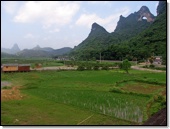 |
| One of the most famous peaks and a tourist attraction, the Moon Hill, with a hole that was once a cave inside the mountain |
|||
After taking a rest at our guide's home, throwing some dice and having a great home-cooked meal, skillfully prepared by guide's husband, we walked to the nearby Buddha Water Cave. Visiting this cave is nothing like visiting a cave at home - they give you special slippers and a helmet on the entry, and for a good reason! Going through the cave is a true adventure that involves lots of squeezing through narrow passes, ducking, using rope and chain, climbing very steep stairs and ladders, going knee-deep through the water... You get to bang that helmet a lot. The cave has two special attractions - a very narrow, several meters long and only 30 cm high horizontal crack, just high enough for a person to wiggle through; and a real mud bath at the bottom of the cave, a naturally-formed pool of thick gooey mud you can jump in. There is even a lake with clear water right next to it to wash off.
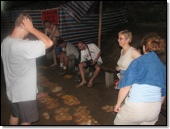 |
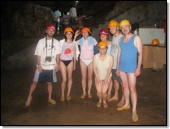 |
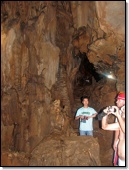 |
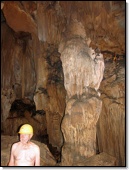 |
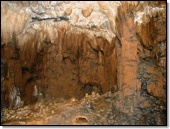 |
| We get equipped at cave's entry | The beginning is easy, as guide points out some of more interesting rock formations |
|||
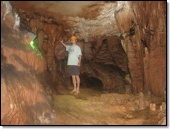 |
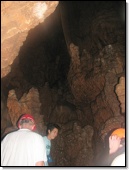 |
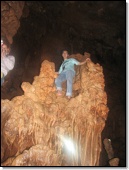 |
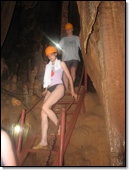 |
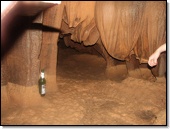 |
| Stalactites resembling breast |
This looks like a Buddha |
A throne | Going deeper in the cave |
We are supposed to crawl through here |
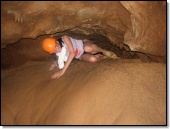 |
 |
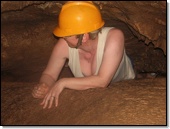 |
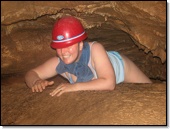 |
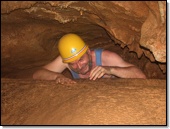 |
| Emerging on the other side, with a photographer waiting | ||||
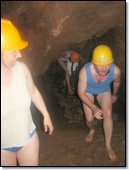 |
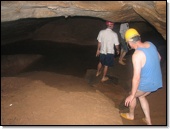 |
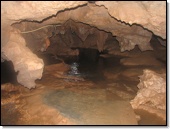 |
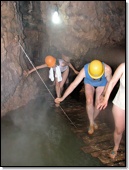 |
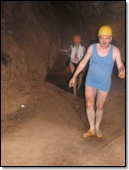 |
| Low and narrow passes |
Most of the cave is wet and slippery |
There are several underground lakes to cross | ||
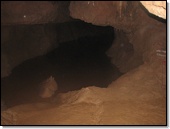 |
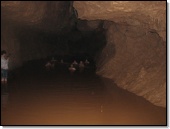 |
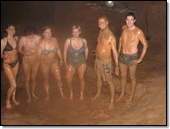 |
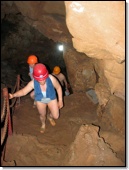 |
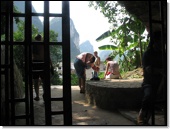 |
| A pool of thick mud deep below the surface... |
...and we are in it! | As muddy as we get | Climbing back out to the daylight | |
In the afternoon we ride our bikes again and cycle back towards Yangshuo, taking a different route. The weather turned slightly cloudy, and it wasn't so hot anymore. We marveled at the scenery all the way, and photos speak for themselves.
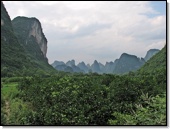 |
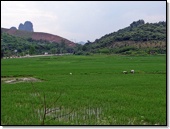 |
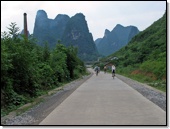 |
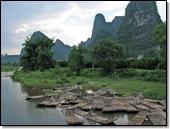 |
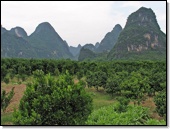 |
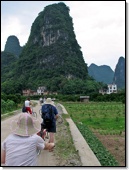 |
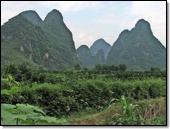 |
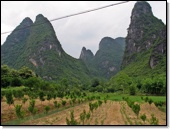 |
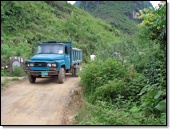 |
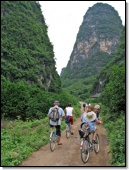 |
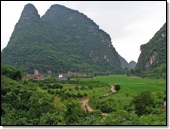 |
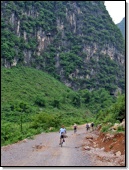 |
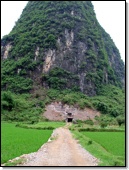 |
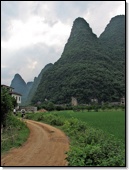 |
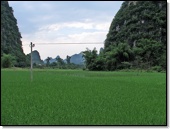 |
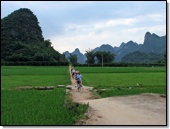 |
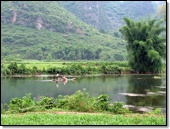 |
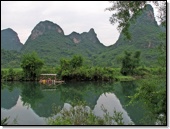 |
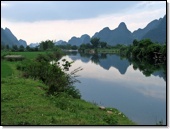 |
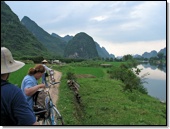 |
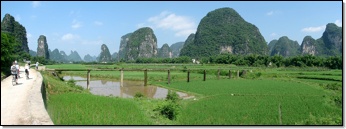 |
 |
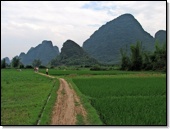 |
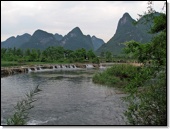 |
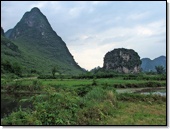 |
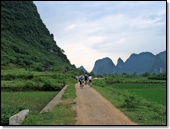 |
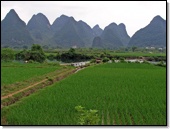 |
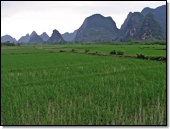 |
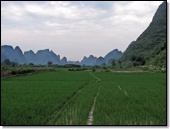 |
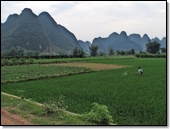 |
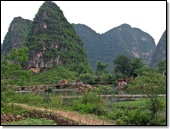 |
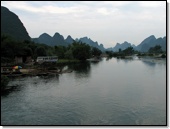 |
 |
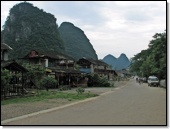 |
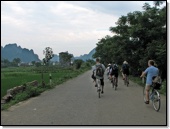 |
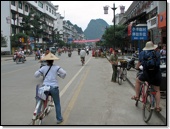 |
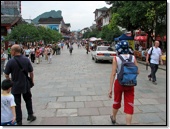 |
| Bamboo rafts on the Li river |
Going through villages surrounding Yangshuo | Back in the Yangshuo crowd... |
...and our West Street | |
We have returned our rented bicycles, went for a quick shower to rinse of the mud, and were ready for the next big undertake of the day. The day is coming to an end, and we are climbing the hill with a TV tower on top that stands high over the city, trying to catch the sunset from there. There is path full of stairs that leads to the top, and takes about an hour to reach the summit. In such humid environment, climbing stairs gets you soaking wet in minutes.
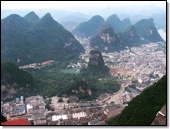 |
 |
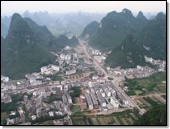 |
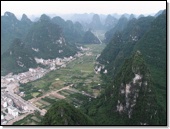 |
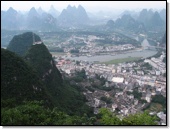 |
| It is too cloudy for a sunset and getting dark already, so we settle for a few photographs of the city | ||||
 |
| A panoramic shot of the Yangshuo from the above |
The next morning in Yangshuo is free for shopping, sightseeing, or just walking around the town.
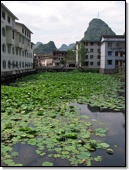 |
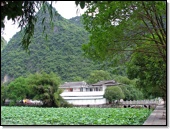 |
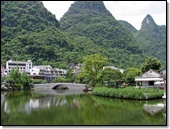 |
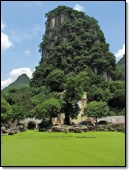 |
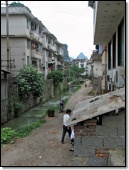 |
| There are several lakes and ponds in Yangshuo, as well as a nice park | One of the Yangshuo back streets |
|||
The afternoon of the last day before flying back to Beijing next morning is reserved for a boat trip. First we take a
local bus line and drive to the small village Pingxin about an hour away. Scenery there is as beautiful as elsewhere,
however this village is famous for the view that appears on the Chinese 20 yuan note.
It was very humid in the morning, and just as we were stepping on the bus the first fat rain drops fell. It was
raining heavily all the way.
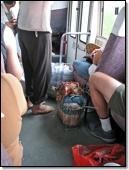 |
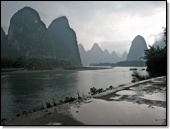 |
 |
 |
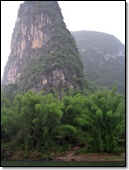 |
| We travel with some chicken |
Compare the scene with the picture on the note | We waited out the rain and embarked on boat when it stopped for a few minutes |
||
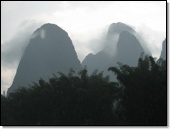 |
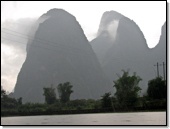 |
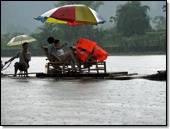 |
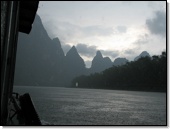 |
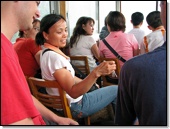 |
| The famous two peaks in heavy rain | This is no fun in a downpour |
Cruising on the river, water is all around |
Our local guide in Yangshuo |
|
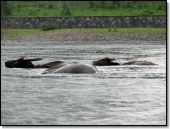 |
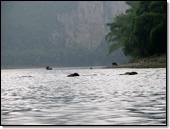 |
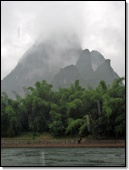 |
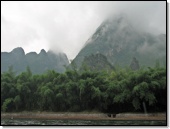 |
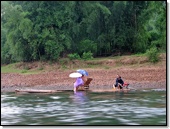 |
| Water buffalos | Peaks are embedded in low clouds | River transport | ||
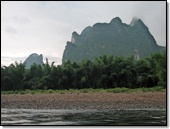 |
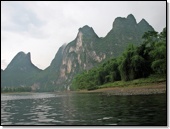 |
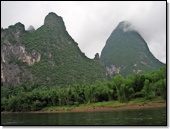 |
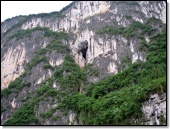 |
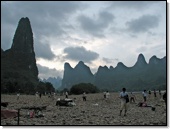 |
| Raining finally stops, and clouds start to disappear | A cave in the wall of rock |
We stop on a particular spot by the river... |
||
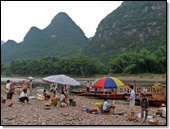 |
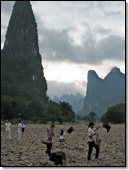 |
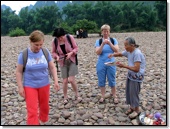 |
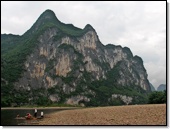 |
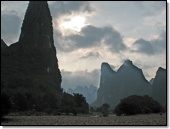 |
| ...and local souvenirs sellers have a real camp waiting for us there | This rocky face contains many images of horses |
The sun is trying to come through dispersing clouds |
||
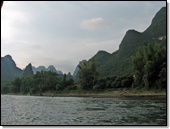 |
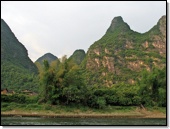 |
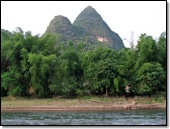 |
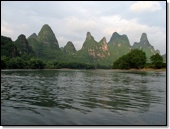 |
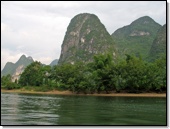 |
| Driving back the same way, the country gets lit by a low setting sun | ||||
 |
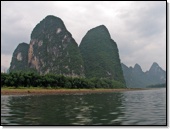 |
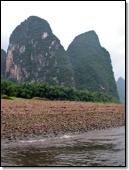 |
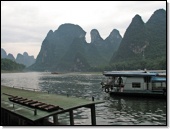 |
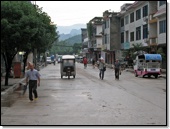 |
| A few more photos of the famous peaks, without the rain | Boats are returning to the harbor |
Pingxin after rain | ||
The next morning we pack up our luggage and leave Yangshuo. We drive back to the Guilin airport, and make a two hours flight back to where we have started in China, Beijing.
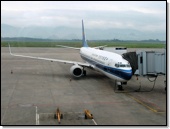 |
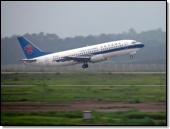 |
| Our brand new B737-800 with leather seats |
Taking off |
Back in Beijing
In Beijing we are reunited with our little colorful brothel, Leo Hostel. As it is about midday, we go first out on a lunch, and then drive through the city to the Olympic Park, checking out the new stadiums, parks, and the Olympic village for the upcoming Beijing 2008 Olympic Games. Apart from a very long and high fence going all around the site there is hardly anything to see, the whole location is one big construction yard, and they seem to be very careful no one sees what's inside until they are finished.
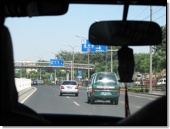 |
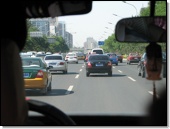 |
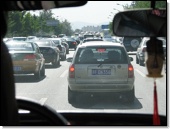 |
 |
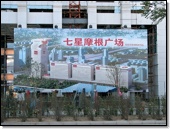 |
| Once again on Beijing streets, and quickly falling into heavy traffic | A lot of building is still going on around the Olympic Park |
|||
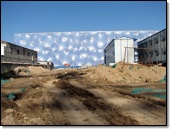 |
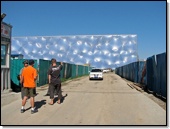 |
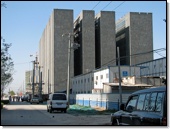 |
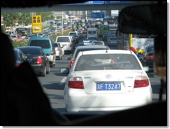 |
| The Water Cube, National Aquatics Centre, is a construction site. The design mimics soap bubbles. |
I guess having a view out is not the point here |
Returning downtown in the afternoon rush hour |
|
It was late afternoon already as we sought out the Chaoyang Theatre for one of the treats of the trip, the Acrobats Show. This show is very popular among both tourists visiting Beijing as well as locals, and is an impressive on-stage demonstration of their breathtaking athletic and artistic skills, at moments seemingly almost superhuman. Many of the performers are kids and teenagers.
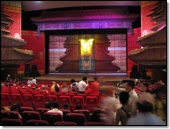 |
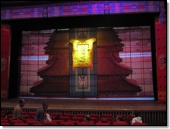 |
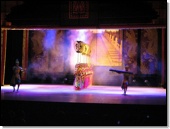 |
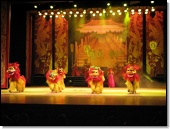 |
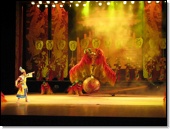 |
| Inside the theatre | The opening presentation |
The show starts on fairly easy, dragons doing the warm-up of the audience |
||
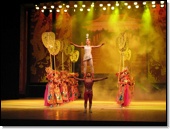 |
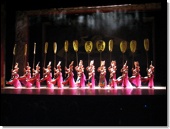 |
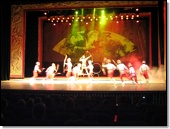 |
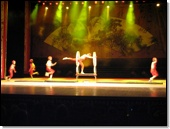 |
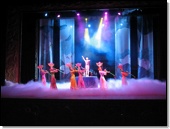 |
| Then everything shifts into a higher gear | Quick paced jumping through various hoops | A very flexible young girl coming on |
||
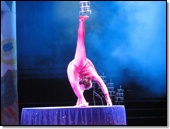 |
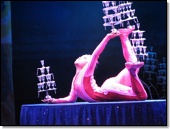 |
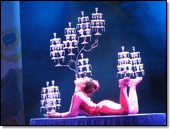 |
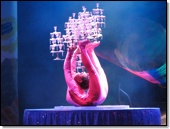 |
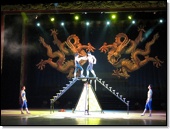 |
| Balancing several stacks of glasses while rolling and twisting | ||||
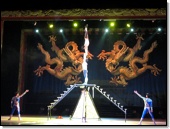 |
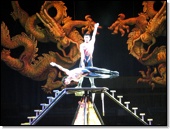 |
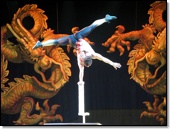 |
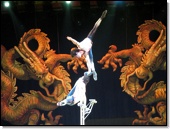 |
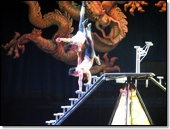 |
| Probably the most difficult act of the evening, incredible strength and balance | He first goes down this way, then back up |
|||
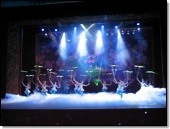 |
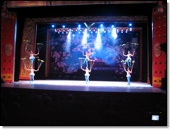 |
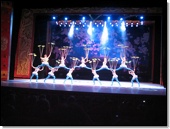 |
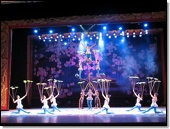 |
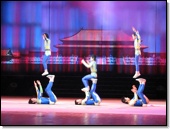 |
| Girls spinning on sticks two dozen of plates each, and performing group figures | Young boys showing off acrobatics skills |
|||
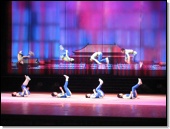 |
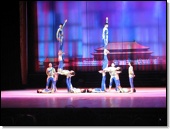 |
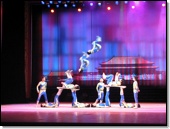 |
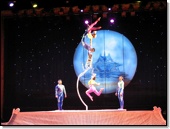 |
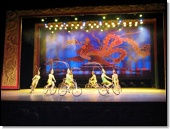 |
| Lots of salts and air time in this act | One more balancing act | Girls on bicycles | ||
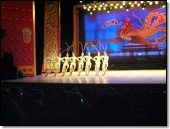 |
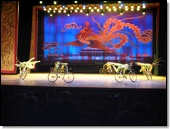 |
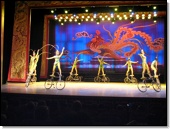 |
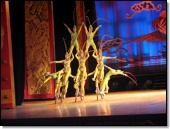 |
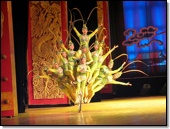 |
| Formations and acrobatics on bikes | How many girls can you fit on a bike? | |||
Shichahai, the city's lake district, was the last stop of the day at the dusk, a delightful area to relax over a drink while watching life on and off the water. Shichahai is beautiful all the time, but has a special attraction in the evening, when the promenade by the lake is filled with neon lights, countless bars and restaurants. Shichahai is often crowded, especially in the evening and on weekends.
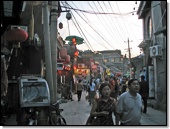 |
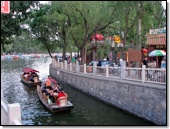 |
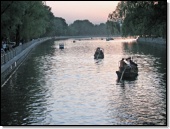 |
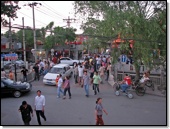 |
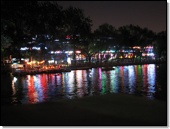 |
| Exploring the local hutongs (narrow alleys) |
You can rent a boat, or just drive in one, and enjoy the scenery |
The old Yingding bridge connecting Front and Back Lake |
The place comes to life at night |
|
We have one last full day in China remaining, the next morning we are flying out from Beijing. In the morning, we went to the Temple of Heaven Park (Tiantan Park), one of Beijing's most impressive parks and more that twice in size of the Imperial Palace. Several times a year, the Emperor would come here to pray for good harvests, enough rain and other heavenly boons. The construction of the Temple is based around the number nine, which is divine in Chinese numerology.
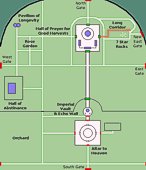 Temple of Heaven Park Map |
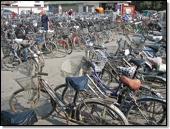 |
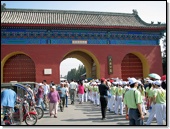 |
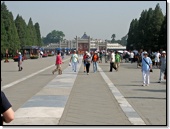 |
 |
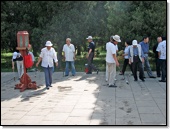 |
| Apparently many come here with bicycles |
The South Gate to the Park |
Walkway to the Altar of Heaven |
Playing Jianzi, kicking around the shuttlecock |
Practicing calligraphy using a brush and water |
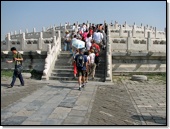 |
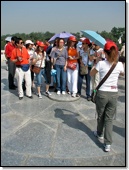 |
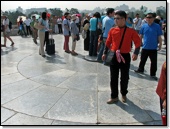 |
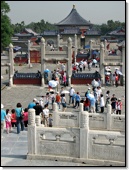 |
| The Altar of Heaven, constructed with details representing the number nine. If you stand in the center, you can hear your own echo. |
Series of small gates between the Altar and the Vault |
||
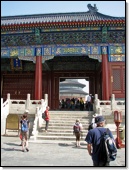 |
 |
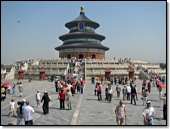 |
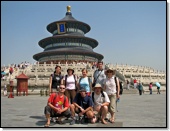 |
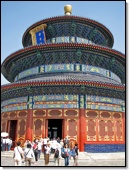 |
| Gate of Prayer for a Good Harvest | The Hall of Prayer for Good Harvest, a 38 meters tall building which does not have a single nail holding it together, it's completely wooden |
|||
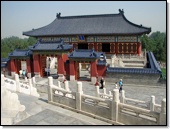 |
 |
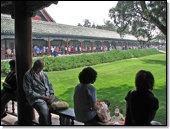 |
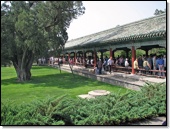 |
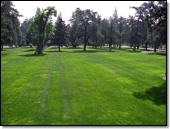 |
| Gate to the Long Corridor |
The Long Corridor is a popular gathering point of local people, engaged in all kinds of social activities |
|||
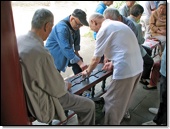 |
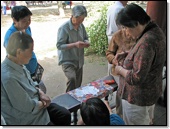 |
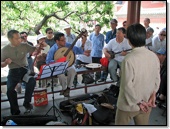 |
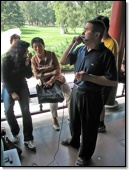 |
| Playing dominos | A card game going on. They do play for money. |
Many amateur bands and singers come here to perform | |
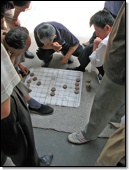 |
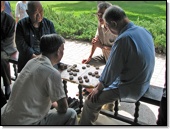 |
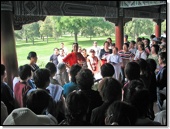 |
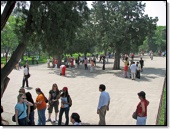 |
| Chinese Chess, or xiangqi, is a popular game among Chinese men |
Singing lessons in a truly professional manner |
There are tourists here, too, but most are locals, starting a day with pleasant activities |
|
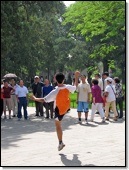 |
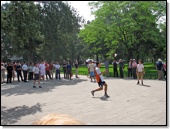 |
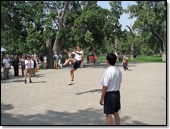 |
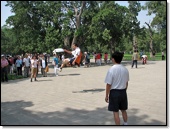 |
| More Jianzi, this time we have a pleasure of watching a real expert and the crowd is loving it | |||
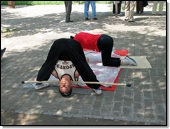 |
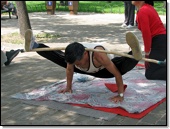 |
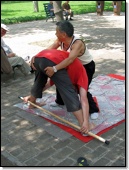 |
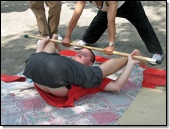 |
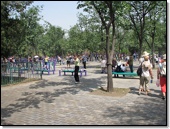 |
| Chinese like to exercise and stay fit, some are really flexible |
It may not be quite as easy as it looks... | A thoroughly equipped exercise area, a fitness out in the open |
||
Feeling all spirited up and energized for the battle ahead, we proceeded directly to the Silk Market for some last day shopping and heavy duty bargaining. Those may have been the most exhausting hours of the whole trip, but at the end of the day we emerged victorious, and with empty wallets.
All there was left for us to do in Beijing the last day there was to pack our luggage and move out to the Beijing International Airport for a flight home.
 |
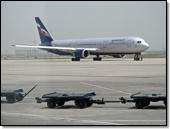 |
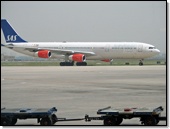 |
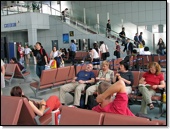 |
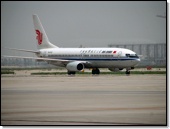 |
| Nearly three weeks after last holding a fork, going home | ||||